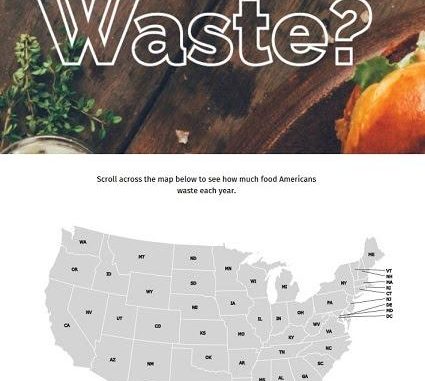
Winter tends to be a very foodie time of year; we’ve had Thanksgiving and Christmas, with all the turkey excesses. All across the nation, families have filled up their freezers, stocked up the fridges, and got supplies for each food-focused gathering. But what happens to everything we buy? Are we as good as we could be about using everything up? Or are we guilty of food waste?
Klein Kitchen & Bath, a remodel and design firm, wanted to find out just how wasteful we Americans are, and surveyed 3,200 of us to find out how much we threw away this past year.
Guilty of food waste? Coloradan households waste over $800 worth of food each year, reveals study.
-
Only 1/4 of people know what the use-by date means.
-
South Carolinians are the most wasteful in the nation.
-
Interactive map reveals food waste across America.
The first discovery was that Colorado households waste $857 worth of food annually, or in other words, over a fifth (21.2%) of their food each month – because it’s gone past its expiration date*.
Broken down by state, the survey found that South Carolinians are the most wasteful, who get rid of $1,304.68 worth of food every year. The least-wasteful state is West Virginia, who’s residents only throw away $404.90 worth of their annual groceries.
To find out how each state compares, check our interactive infographic map: https://kleinkitchenandbath.com/2018/12/10/guilty-of-food-waste/ (click on ‘embed’ to host)
So why are we being so wasteful? It seems that the misunderstanding of food labelling might be a huge factor. The survey found that nearly half of respondents (48.9%) won’t eat food that’s marked as past its sell-by date – but perhaps that’s because they are misinformed about what the sell-by date actually means – it is the last date by which it must be sold in a store; however, after that, it’s still good to eat (even if it’s past what’s marked as the use-by date).
Again, the label – use-by date – caused confusion: only one-quarter knew that it signifies the last date for use of the product at its peak quality. Nearly a third (30.4%) believed that it was the last date the product was edible, almost a quarter (22%) thought it meant that it was the last date the food product could be displayed and sold in a store, and finally, 21% thought it meant the date that the product would be at its best flavor and quality – when, in fact, this is the ‘best-by‘ date (interestingly, while these guides are in place, they don’t actually say that this is the last date a product can be eaten by – that part is up to you, the consumer. You can eat something beyond the guidelines, but just give it a check over, or a ‘sniff test’ first before eating).
Over half (51.1%) of people believe that best before dates on fruits and vegetables should be scrapped altogether because they say it’s easy to tell if something has gone off just by touching it. The survey also found that the foods Americans would be most likely throw away are dairy products (46.6%); followed by meat (22.3%); fish (19.2%); bread (5.1%) and vegetables (8.5%).
Klein Kitchen & Bath have provided advice below on how you can be more resourceful with your food, and so hopefully will be able to throw less away in the future:
- Freeze your food. You can actually freeze the food right up till the use-by date, and it will be good to eat months later! (Just double check what you can or can’t freeze – not everything can go in, like soft cheeses).
- Freeze milk into an ice cube tray! As the survey revealed, most people will throw away dairy products first – well now they can use this handy tip instead of wasting. Use the frozen milk cubes in coffee or tea!
- Put your herbs into a glass of water to prevent them from wilting quickly, they will last much longer!
- If yogurts are getting near their use-by date, you can mix them up with some over-ripe fruit for a smoothie or even freeze into ice-lollies!
- Turn stale bread or crusts into breadcrumbs by putting them in a food processor. Fantastic when mixed with herbs or onions as a stuffing for chicken or to top baked fish!
- When cooking with foods such as potatoes, broccoli, or carrots, use it all. You don’t need to remove the peel or cut the stems off, as they often have additional nutrients in! And if you don’t like the peel or stem, you can compost what you don’t use.
- Donate the items you might be close to throwing out which aren’t yet out of date. There will be plenty of food kitchens nearby that would really appreciate anything you have which is going spare.
“It seems we need to educate ourselves a little better on what we can eat and when,’ says Eric Klein from Klein Bath & Kitchen. “Just being familiar with the difference between, say, sell-by dates and use-by dates can help us be less wasteful.”
*data calculated by using the amount spent annually by each American household (figure taken from the Bureau of Labor Statistics), and asking households how much food they throw away at the end of every month (%).
Support Northern Colorado Journalism
Show your support for North Forty News by helping us produce more content. It's a kind and simple gesture that will help us continue to bring more content to you.
BONUS - Donors get a link in their receipt to sign up for our once-per-week instant text messaging alert. Get your e-copy of North Forty News the moment it is released!
Click to Donate